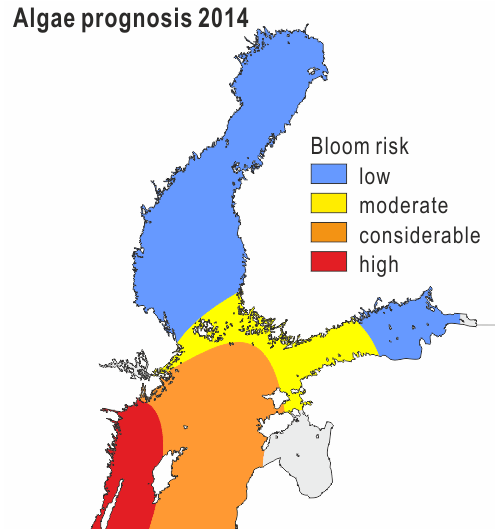Press release 2014-06-05 at 10:16
According to the algae prognosis from the Finnish Environment Institute’s Marine Research Centre, the risk of blue-green algal blooms is moderate in the western part of the Gulf of Finland, the Finnish Archipelago Sea, and the southernmost parts of the Bothnian Sea. In the southern parts of the Finnish Archipelago Sea and the northern part of the Baltic Proper, the risk of algal blooms is considerable. The risk of algal blooms is greatest in the western parts of the Baltic Proper. In the Bay of Bothnia, the majority of the Bothnian Sea and the eastern parts of the Gulf of Finland, the risk of algal blooms is low.
The probability of extensive blue-green algal blooms in Finland’s sea areas is slightly higher than it was last year. The increased risk in the Baltic Proper is due to phosphorous-rich deep water mixing with surface layers as a result of storms in late autumn and winter 2013-2014. Ultimately, the summer weather is the decisive factor determining when and in which areas major surface accumulations occur. Warm and calm weather increases the risk of major surface accumulations.
The bloom period in Finland's sea areas is expected to peak in late July and early August. The marine blooms of the species Aphanizomenon flos-aquae start to become more abundant when the sea surface temperature reaches ca15 degrees centigrade. As the sea surface temperature exceeds 17 degrees centigrade, the hepatotoxin-forming species Nodularia spumigena may also begin accumulating at the surface.
The algae prognosis details the risk of algal blooms in open sea areas. In coastal areas, blue-green algal blooms have normally occurred from time to time especially in the Finnish Archipelago Sea, as well as the coasts of the Gulf of Finland and the southern Bothnian Sea.
Basis for the risk assessment
The blue-green algal bloom prognosis is based on estimates performed using the ecosystem model in use at the Finnish Environment Institute SYKE. The estimates are based on sea current, wind, and temperature conditions over five selected years, as well as nutrient concentrations in the previous winter, and changes in these nutrient concentrations during the spring. The expert assessment also considers the uncertainty issues of the model and draws on experience of former prognoses and accumulated observational data.
State of the Gulf of Finland and the Baltic proper
Small concentrations of phosphorous nutrients (phosphates) that accelerate the growth of blue-green algae still remain in the surface layers of the Gulf of Finland after the peak bloom period of phytoplankton in spring, which moderately increases the risk of algal blooms in the area. In the Baltic Proper, particularly west of the island of Gotland, phosphate concentrations have been considerably high, which significantly increases the risk of algal blooms in these areas.
The levels of dissolved oxygen in the western Gulf of Finland are very low, and hydrogen sulfide was also observed in the area in May. This is a result of water of high salinity and low oxygen content flowing from the Baltic Proper into the Gulf of Finland. This phenomenon has been observed from time to time and has to do with the normal fluctuations of the Baltic Sea, caused by weather conditions, among other factors. Oxygen levels in the eastern Gulf of Finland are good, as the saline and low oxygen water from the Baltic Proper has not reached this far east. The mild and relatively iceless winter also facilitated effective mixing of water masses in the area.
Regular bulletins on algal blooms starting
Starting this week and continuing until the end of August, the Marine Research Centre of the Finnish Environment Institute SYKE will provide weekly updates on the algae situation in the Baltic Sea.

More information
Algae prognosis
Researcher Sirpa Lehtinen, SYKE Marine Research Centre, firstname.lastname@ymparisto.fi, tel. +358 (0)295 251 353
Senior Research Scientist Seppo Knuuttila, SYKE Marine Research Centre, firstname.lastname@ymparisto.fi, tel. +358 (0) 295 251 286
Ecosystem models
Researcher Kim Dahlbo, SYKE Marine Research Centre, firstname.lastname@ymparisto.fi, tel. +358 (0)295 251 096
The state of the Gulf of Finland
Senior Research Scientist Mika Raateoja, SYKE Marine Research Centre, firstname.lastname@ymparisto.fi, tel. +358 (0)50 535 5709
Communications
Communications Chief Sirpa Pellinen, SYKE communications, firstname.lastname@ymparisto.fi, +358 (0)295 251 502